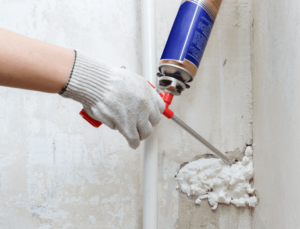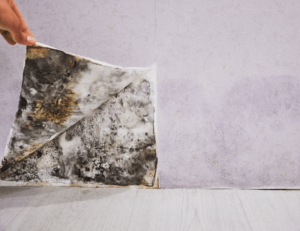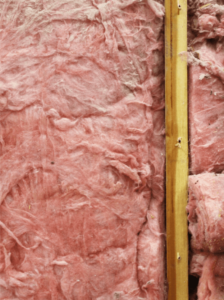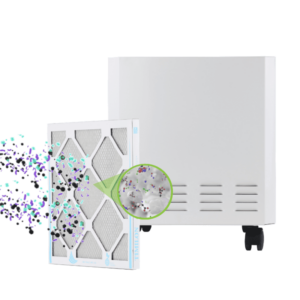Do You Need Attic Ventilation with Spray Foam Insulation?
Did you know that the United States Federal Housing Authority recommends that every home has a minimum of at least 1 square foot of attic ventilation for every 300 square feet of attic floor space? It is no surprise that many homeowners and builders believe that it is essential that attics should be properly ventilated inside of a home or other indoor environment. Attic ventilation works to protect the indoor structure of buildings in many ways such as maintaining a cold roof temperature to control ice dams, to vent moisture that moves from the conditioned space to the attic, to vent and expel solar heated hot air from the attic to lessen building cooling, etc. All of these components are important to maintaining a safe and effective infrastructure, and thus the increasing need for proper and safe attic ventilation.
When it comes to the various types of attic insulation used throughout building structures, one of the most popular to use is spray foam insulation. Spray foam has been used for the past 30 years due to its ability to rapidly expand and fit into a given space such as in an attic or other areas of your home and/or building. However, there have been many questions regarding both the effectiveness and safety of using spray foam insulation in an attic and whether or not there is another type of attic insulation that should be used in lieu of spray foam.
In this article we are going to learn more about attic ventilation insulation, understand why do you need attic ventilation with spray foam, and the potential health risks and environmental risks of using spray foam inside your home’s attic.
What is Spray Polyurethane Foam for Attic?
 Spray polyurethane foam is a chemical product that is created by two materials, isocyanate and polyol resin, that will react with each other when they are mixed and will expand up to 30 to 60 times its liquid volume as it is sprayed in place. This alternative to traditional building insulation [fiberglass] can be applied into wall cavities, holes, concrete slabs, and even onto roof tiles and attic insulation. Spray polyurethane foam will provide thermal insulation that will minimize air infiltration which can help to save on heating and cooling costs within the indoor environment. Insulation is used in an attic for cross-ventilation to minimize potential for moisture accumulation and condensation to help energy savings and moisture control.
Spray polyurethane foam is a chemical product that is created by two materials, isocyanate and polyol resin, that will react with each other when they are mixed and will expand up to 30 to 60 times its liquid volume as it is sprayed in place. This alternative to traditional building insulation [fiberglass] can be applied into wall cavities, holes, concrete slabs, and even onto roof tiles and attic insulation. Spray polyurethane foam will provide thermal insulation that will minimize air infiltration which can help to save on heating and cooling costs within the indoor environment. Insulation is used in an attic for cross-ventilation to minimize potential for moisture accumulation and condensation to help energy savings and moisture control.
Traditionally, insulation materials that are placed inside of an attic will require air circulation within the attic space to assist in drying excess moisture in this indoor space. The attic ventilation can ultimately reduce condensation that may build up in the attic during winter and summer months; primarily because winter can cause moisture that stems from warm moist air infiltrating into the attic space from the occupied areas in the home, and summer can bring in warm moist hair that can cause condensation.
Problems with Spray Foam Insulation in Attics
The use of spray foam attic can present many potential problems, especially when it comes to the improper installation of this material within this area of your home. Spray foam installers may miss some of the air leakage sites in the attic, which can lead to problems in the insulation of the attic. When there are air leaks that occur in an attic it can lead to energy efficiency problem within the environment which can mean higher energy bills. Additionally, the application of too much or too little spray foam can also become a major issue in an attic insulation. When there is too much spray foam that is added to a specific area in an attic, the expanding foam can envelop the boundaries between conditioned and unconditioned space. Whereas too little spray foam insulation can leave for thermal bypass because of the complete lack of insulation in the attic.
Moisture is also another huge issue when it comes to spray foam insulation in an attic. It has been said that insulating with spray foam insulation at the roof line will lead to moisture problems with the roof sheathing. One of the most common reasons to put spray foam on the roofline is to avoid having to air-seal the attic floor, because the attic is connected with the air in the house and indoor air is more humid than outdoor air which can cause moisture problems.
Spray Foam Insulation Mold Problems
 As we have discussed previously, spray foam insulation can effectively seal roofs and other spaces where condensation is more likely, such as an attic. These insulation materials are not only used to insulate home to bar air from coming in and out but to also protect the space from elements such as mold, rodents, moisture, and dust. Moisture, in particular, is a major problem that comes with attics because of the warm air that comes into contact with the cool surfaces that will condense and stay in the space. This accumulation of condensation in this space can lead to mold growth, mildew build up and even structural weakness to the home.
As we have discussed previously, spray foam insulation can effectively seal roofs and other spaces where condensation is more likely, such as an attic. These insulation materials are not only used to insulate home to bar air from coming in and out but to also protect the space from elements such as mold, rodents, moisture, and dust. Moisture, in particular, is a major problem that comes with attics because of the warm air that comes into contact with the cool surfaces that will condense and stay in the space. This accumulation of condensation in this space can lead to mold growth, mildew build up and even structural weakness to the home.
According to the EPA, spray foam insulation is one of the best insulation materials used to minimize moisture-related problems that are caused by random air leakages that fill all the cracks and crevices where air can enter into the environment. Therefore, the use of spray foam can be significantly beneficial to minimizing mold problems in the indoor space of your attic.
Types of Spray Foam Insulation
When it comes to the various types of spray foam insulations that are used within a home’s structure such as the attics within these indoor spaces. Each spray foam type and method of application will offer unique benefits to the space, as they will contain different capabilities when applied onto a surface in your home. There are three primary types of SPF that can be used for insulation and other specific purposes in the environment, these three types of spray foam insulation include the following; high-density, medium-density, and low-density spray foam insulation.
 High-Density Spray Foam: Home builders will usually prefer the use of high-density spray foam insulation when utilizing this SPF as the main source of insulation in the space. This foam will contain a higher density that other SPF types, such as medium and low-density foam – as the name clearly states. When the spray foam contains a higher density, it will not expand as much as lower density foams, this can lead to the need for more SPF material to cover and insulate the entire given space. Mainly, high-density spray foam will be used in roofing and/or other exterior insulation due to its seamless, solid nature. Additionally, similar to the other spray foam insulation types, this spray foam will help to reduce energy costs because of its thermal resistance and will also offer increased protection against water and air infiltrations.
High-Density Spray Foam: Home builders will usually prefer the use of high-density spray foam insulation when utilizing this SPF as the main source of insulation in the space. This foam will contain a higher density that other SPF types, such as medium and low-density foam – as the name clearly states. When the spray foam contains a higher density, it will not expand as much as lower density foams, this can lead to the need for more SPF material to cover and insulate the entire given space. Mainly, high-density spray foam will be used in roofing and/or other exterior insulation due to its seamless, solid nature. Additionally, similar to the other spray foam insulation types, this spray foam will help to reduce energy costs because of its thermal resistance and will also offer increased protection against water and air infiltrations.- Medium-Density Spray Foam: In comparison to high-density spray foam, medium-density spray foam is applied as a low or high-pressure two component polyurethane spray foam. This type of spray foam offers the specific benefits of continuous insulation, interior wall cavity fill, and unvented attic applications. This medium-density spray foam is a closed-cell spray foam that is typically used where there is the need for R-value insulation per inch possible. This will help act as an air, vapor, and water barrier, as well as helping to reduce noise.
- Low-Density Spray Foam: An open-cell foam, low-density spray polyurethane is a spray applied to provide continuous insulation and an air-sealing barrier. This spray foam is applied as a low or high-pressure, two-component polyurethane spray foam that can be applied onto walls, in unvented attics, to ducts and ceilings, and in vented attics and crawl spaces. It is also known to act as an air barrier, however, unfortunately it will not protect against vapor and moisture intrusions.
Spray Foam Off Gassing & Health Issues
The use and application of spray polyurethane foam into a work site of a home should be an activity that is restricted to those people who are not wearing the appropriate personal protective equipment (PPE). There are a variety of chemicals that are used in spray foam insulation such as polyol, flame retardants, and even a hazardous chemical known as isocyanates. These chemicals used within the construction of spray foam insulation will be most prominent and noticeable to those exposed to these areas where spray foam was applies is during its drying or “curing” time. According to the Environmental Protection Agency (EPA), curing of spray foam means that the chemicals in the product are reacting to produce polyurethane foam. It is recommended from some spray foam insulation manufacturers that individuals and workers await 24 hours after the application of the two-component high pressure material. This curing or releasing of chemicals from spray foam is what is known as off gassing, where the chemicals from spray foam are released into the air as it dries in the environment.
In addition to spray foam off gassing, there are also health issues that will be associated with the chemical off gassing of spray foam in a home’s attic or other spaces in the indoor environment. The EPA has stated that individuals with a history of skin conditions, respiratory allergies, asthma, or prior isocyanate sensitization should carefully consider exposure to spray polyurethane foam (SPF).
How Long Does Spray Foam Insulation Last
One of the major benefits of using spray foam insulation within the structure of your home is its durability to last in the space for a longer period after its initial installation. When the spray foam is properly installed, it is said that the spray foam can last the entire lifetime of the home. Additionally, when spray foam insulation is used in roofing application it will last for upwards to 30 years with proper maintenance. However, when applying the spray foam insulation within the structure of a building it is important to do so properly, as missed areas will create holes that will allow for air flow and other problems to occur that will potentially compromise the lifespan of the spray foam insulation.
How to Get Rid of Spray Foam Insulation Smell
When spray foam is properly applied by a professional, the spray foam will likely emit fume levels in the environment that will dissipate over time in the air of the indoor space. As these fumes release into the air it can taint the indoor air quality in your home or whatever indoor space the spray foam was applied within, as well as potentially aggravate human health when exposure occurs. One of the most prominently used methods for removing indoor air contaminants from these air spaces is through the use of home air purifiers. An air purifier is an air quality device that works to take in and filter out pollutants from the air such as noxious odors, chemicals, and even allergens from the air. However, not all air purifiers work the same and when it comes to chemical neutralization there are only a limited number of air purifiers that can accomplish this neutralization.
 The EnviroKlenz Air Purifier is a noxious odor and chemical neutralizing air purification device that works to actually capture, contain, and neutralize these airborne pollutants. EnviroKlenz uses a patented earth mineral technology that is both non-toxic and chemical free to safely and effectively neutralize noxious odors and toxic chemicals from the air, this includes VOCs and other chemicals like isocyanates. The second stage filtration used within this EnviroKlenz Air Purifier is a hospital-grade HEPA filter that is effectively capable of capturing and removing 0.3 microns from the air at a 99.99 percent efficiency.
The EnviroKlenz Air Purifier is a noxious odor and chemical neutralizing air purification device that works to actually capture, contain, and neutralize these airborne pollutants. EnviroKlenz uses a patented earth mineral technology that is both non-toxic and chemical free to safely and effectively neutralize noxious odors and toxic chemicals from the air, this includes VOCs and other chemicals like isocyanates. The second stage filtration used within this EnviroKlenz Air Purifier is a hospital-grade HEPA filter that is effectively capable of capturing and removing 0.3 microns from the air at a 99.99 percent efficiency.
Article Sources:
- Wikipedia: Spray Foam (link)
- Environmental Protection Agency (EPA): Spray Polyurethane Foam (SPF) Insulation and How to Use it More Safely (link)
- SprayFoam: Types of Spray Foam and Advantages (link)
- Environmental Protection Agency (EPA): Potential Chemical Exposures from Spray Polyurethane Foam (link)
- Environmental Protection Agency (EPA): Health Concerns About Spray Polyurethane Foam (link)
Comments
Post a Comment